Photos by Drew Ruiz and Simon Cudby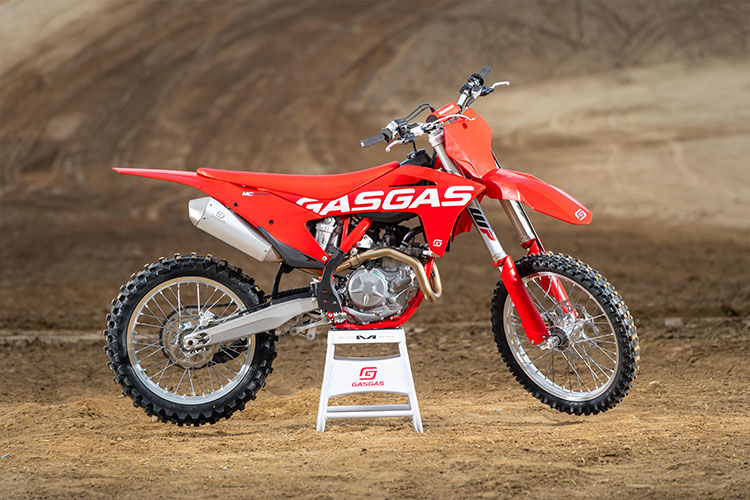 Thought the short association KTM has with Gas Gas, the Spanish brand’s history may not be clear (or understood, or even yet matter). Because If my memory is clear, Gas Gas made a MC250 motocross bike, and I tested it for Cycle World Magazine back in the late 90s. This because MX bikes sold so well in the US and the brand was looking to grow. So these will not be the first stab at the market, thought the last one was and enduro bike with different (and I remember quite challenged) suspension.
Thought the short association KTM has with Gas Gas, the Spanish brand’s history may not be clear (or understood, or even yet matter). Because If my memory is clear, Gas Gas made a MC250 motocross bike, and I tested it for Cycle World Magazine back in the late 90s. This because MX bikes sold so well in the US and the brand was looking to grow. So these will not be the first stab at the market, thought the last one was and enduro bike with different (and I remember quite challenged) suspension.
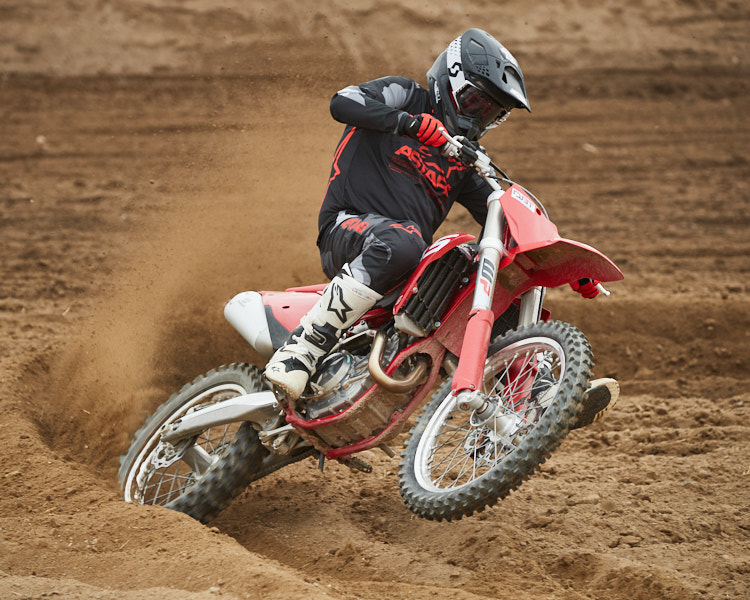
For 2021 the Gas Gas MC line will mirror ever so closely the KTM‘s SX models. But there are a few deviations from those bikes as well. Likely the biggest and most visual change aside from the color is the use of the cast triple clamp. WP Aer air fork is used in conjunction with a linkage activated WP shock and the settings are the same as world-market KTM SX bikes despite what we were told through the PR department. They said “specifically designed for the Gas Gas line.” We were told that the setting was intended to be softer or less aggressive than the standard KTM US-spec lineup. Since the US R&D department had little to no time on the Red bikes, we suspect the setting was the easiest thing to do. Also the US-spec is generally too stiff for anyone but top-level MX racers and those magazine test riders who think they are that. And since we in the US run a little thick on the scale, some of us can use the setting in another way (read: stiffer spring.)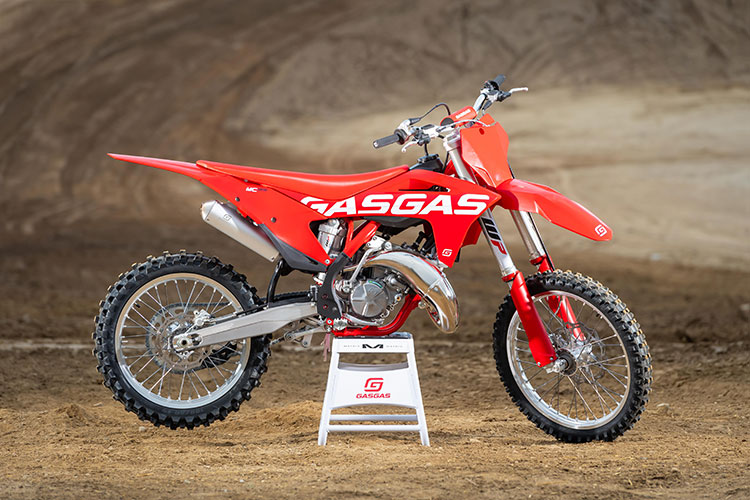
In the beginning part of the day since we are sharing bikes with other publications, it was obvious that these bikes did not have the break-in time that we are often used to when testing. So the suspension was difficult to assess. We felt that the initial part of the stroke, especially in the forks, was a little bit harsh. So at this time it was pointless to chase around clicker settings. Of note here is the use of the Maxxis tires which are different than the usual Dunlop’s. Since we do not have a lot of experience with these it would be difficult to tell how the tire is playing into the feel of the fork and shock. Interestingly enough, when we did come back in after half a lap on a bike that had been ridden by a few other so-called high-level journalists, we complained or at least asked to have the air pressure in the tires checked. 35 PSI front and somewhere around 40 PSI in the rear was not the ideal setting to be doing any evaluation with. We had it put back to 12 PSI and then continued riding… So be careful of the opinions of some of the riders telling you how a bike works. And no, a manufacturer will rarely go back and inform a test rider that this was an issue–because that would insult the intelligence of said riders who can’t tell the difference tire pressure makes. At least those reviewers or influencers or whatever they are called today are a lot faster and getting their information up on the Internet than us, so there is that!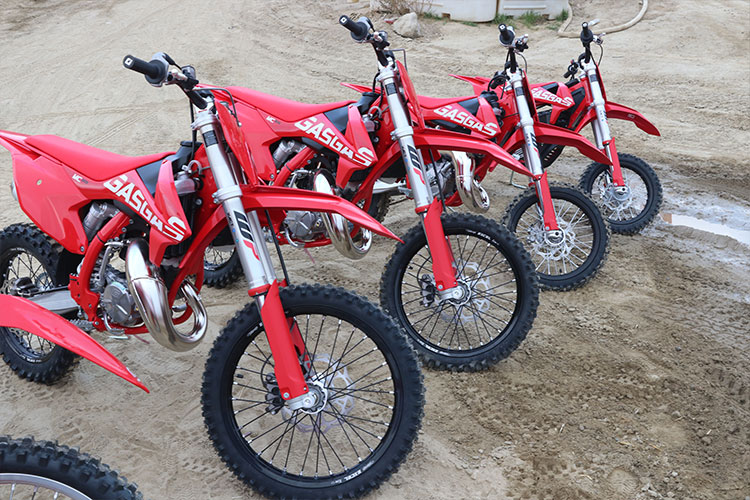
So we rode till the end of the day and took both the 250 and 450 motocross bikes back out when they had a few hours on them. Now the initial suspension stroke had broken in and softened up a noticeable amount where it was moving a lot more freely. Here you can feel that the overall action of the suspension is softer through the mid-stroke but still has good bottoming resistance. Yet in comparison to the rest of the stroke the initial just feels a little stiff. You feel the ground a bit more. This would be the opposite feel you would expect out of the cast clamp but then again the bar mounts are solid, not rubber mounts as in some of the billet machined clamps. On the 450, since the back-end acts a little soft, it makes the front feel even stiffer initially. We’d say that this setting is better for most riders in the real world if riding more vet-style courses. The more free action allows the suspension to move, absorb and get traction more than a stiffer setup that bucks and has a lot of hold-up that pro riders and now a lot of magazine guys demand. The bikes did not wally or feel vague at any time and we know that chassis is tuned properly so the suspension is fine. We ran 105mm of sag on all the bikes and were able to get that number even on the MC 125 with our 200 lb. rider. But yes, a stiffer spring on the 125 would be a necessity for someone of that weight.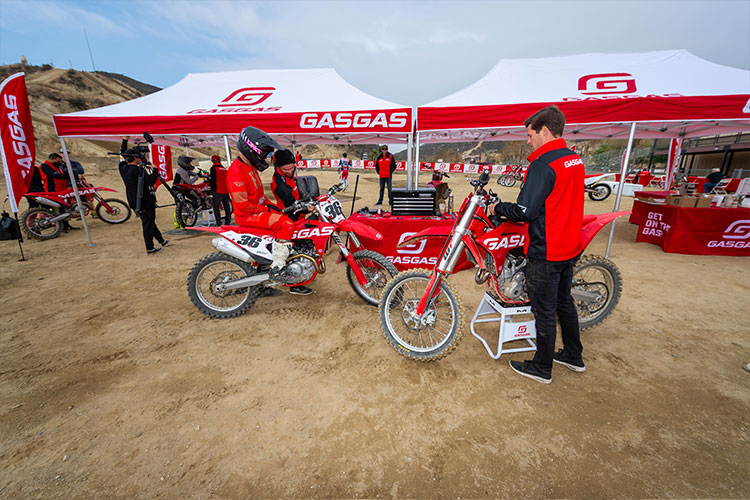
There was not enough time or the ability to do any sort of back to back comparisons to see if the triple clamp makes that much of a true difference. But we’d suspect that most riders would not be able to really notice it. In reality, the biggest change most would feel will likely arise from the use of different tires. Speaking of the Maxxis tires they got really good traction when the dirt was loamy and are very comparable to the Dunlop’s that typically come on most motocross bikes. If being picky they were a little less predictable when transferring from really good dirt to hardpack.
In the engine departments we’ll break them down by bike:
MC 125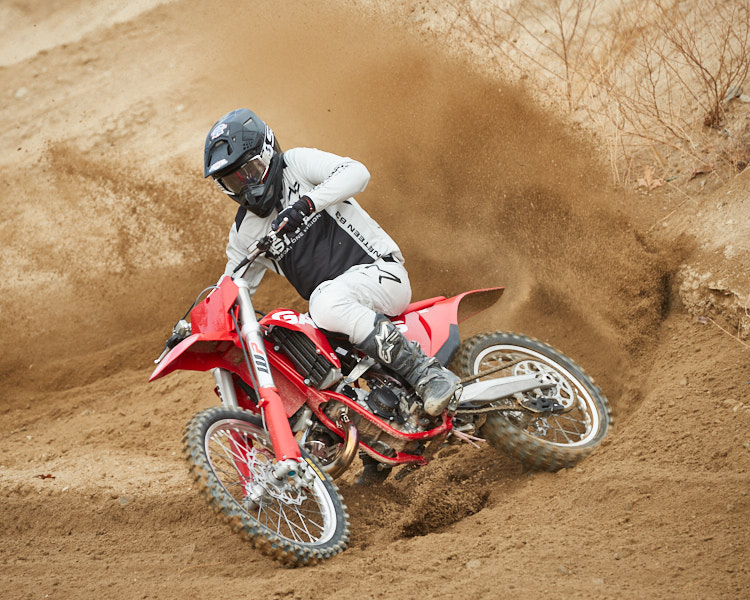
This screaming 125cc two-stroke is the typical long revving, top-end happy eighth-liter KTM is famous for. It puts out an insane amount of power for a 125 but it also has a catch. The throttle needs to be wide-open and the more RPM the better. Jetting was spot on and it has great throttle response at most higher RPMs and bigger throttle openings. But if you are down a little in the RPM the bike really does not pull that hard or fast. It carburates good but it just does not want to build up without a downshift or a lot of clutch work. This would be less apparent for a lighter rider but it is still how this engine was designed to make so much power on top. You keep it running there. The torque to pull you is there and it will keep the engine chugging but for it to really go, again, wide open is where this engine thrives.
The six-speed gearbox is spaced perfectly, shifts effortlessly and was even fine with Glen Helen’s uphills and a fatter rider. The clutch is magical and it has to be on this bike with all the shifting necessary.
MC 250F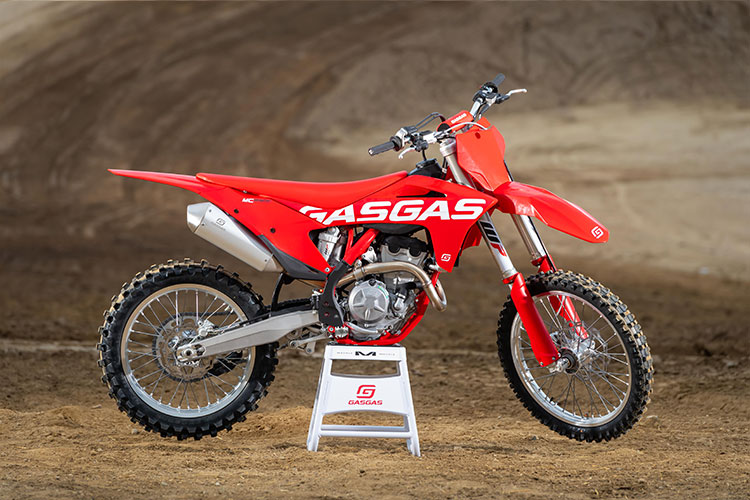
Again, the character we know from the smaller displacement KTMs is alive in the Gas Gas as the engine is basically identical except for the exhaust on the MC. It lacks the resonance chamber on the header section of the exhaust. What may play into the even more top-end heavy feel of the power delivery as the resonance chambers often help low-end throttle response. The wrist to wheel connectivity is excellent as we have come to expect from fuel-injection and the bike responds at any RPM and throttle opening but the more RPM the better the result. Right up to the rev-limiter where there is very little sign-off before hitting it. That is not to say that when you are way up there in RPM and you give it the beans, sometimes you might even feel this is like a 350cc. The pull from the mid is very reminiscent of a 350cc and very pronounced for a 250cc from any brand. On top, the Gas Gas makes class-leading 250cc four-stroke power and makes a little bit more noise than the KTM when doing it according to others at the track. They have a little more crack or bite when you snap the throttle—sound to your ear. Like the 125, more RPM is better at any time so smooth shifting and a great clutch were welcomed.
The four-stroke test bikes had the accessory mapping and traction control switch installed and the changes were a little less noticeable than what has become common on the KTM‘s. Over the last few years, KTM have made the maps have a little more differentiation yet the maps in the Gas Gas test bikes seemed very similar on this track.
MC450F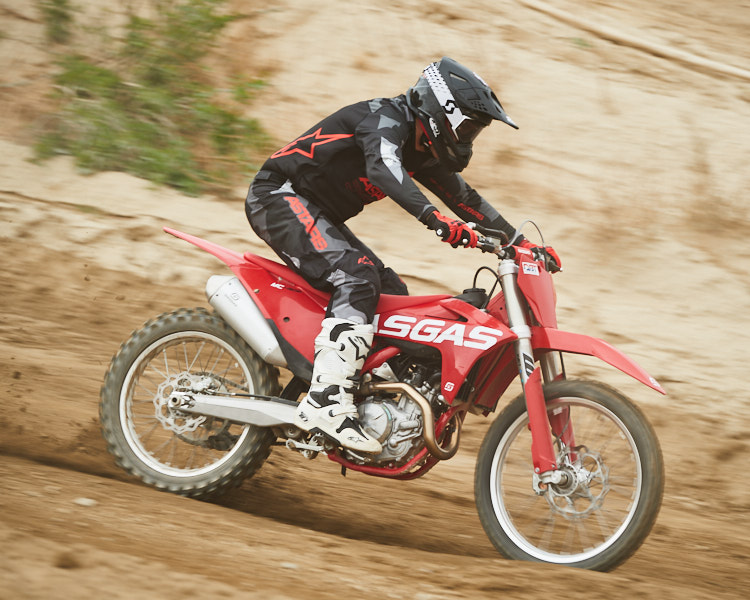
The powerhouse of the Gas Gas line did not disappoint in power. On the big bore KTM-built engine the characteristic of having a light crankshaft yet torquey feel is carried over. There isn’t much rotating mass to slow the pick-up and response of the engine and it makes serious power right from the bottom and has a progressive build all the way to the top. Make that very progressive or exponential would be an even better description. Of the 450cc four-strokes this engine seems to have the smoothest power delivery down low and for some the least power on the bottom end. But this changes drastically as the revs increase and once you are in the mid-range on up there is no mistaking this for anything but a 450cc racer. Riders that like to rev the 450cc engine get along better than riders who prefer to chug this engine. Or at least those that want to go really fast. More novice speed riders will appreciate that they can be comfortable riding this 450 in the bottom and mid without it getting out of hand. It seemed like there was more snap or hit coming into the mid range-likely from the exhaust change, compared to the KTM and Husky bikes we have ridden lately. This is also something that may be better for riders who appreciate some extra hit character in the power delivery. Using it to get over obstacles where faster riders use RPM.
With the accessory ignition map switch the maps, again, were harder to differentiate and we even felt the “aggressive” map number 2 was more mellow. Traction control works for some riders bet we tend to let our wrists do that for us on the motocross track under normal conditions. Shifting on the 450 we rode was not so good and we missed a few shifts, which seemed out of character. The clutch was great as usual.
On all of the MC bikes the brakes were strong and aggressive, never lacking power. The plastic looks sharp and we did not notice anything different because of it. Yet we do know of cases where riders are inflected by the color of a bike and we can say that with a certain breed the Red color has a very positive effect. The direction of the KTM group with this brand is smart and likely going to be very successful, especially if they keep the pricing in check and continue to see that the real world rider may want something different than what a magazine test rider tells them is good. With three brands to play with it will be an interesting experiment and sales numbers and regular rider’s opinions will tell the story.
Want to know about the Gas Gas Enduro bike? Click Here
For More Gas Gas MX info, Click Here
Support DBT, Shop and search for products through the link below:


